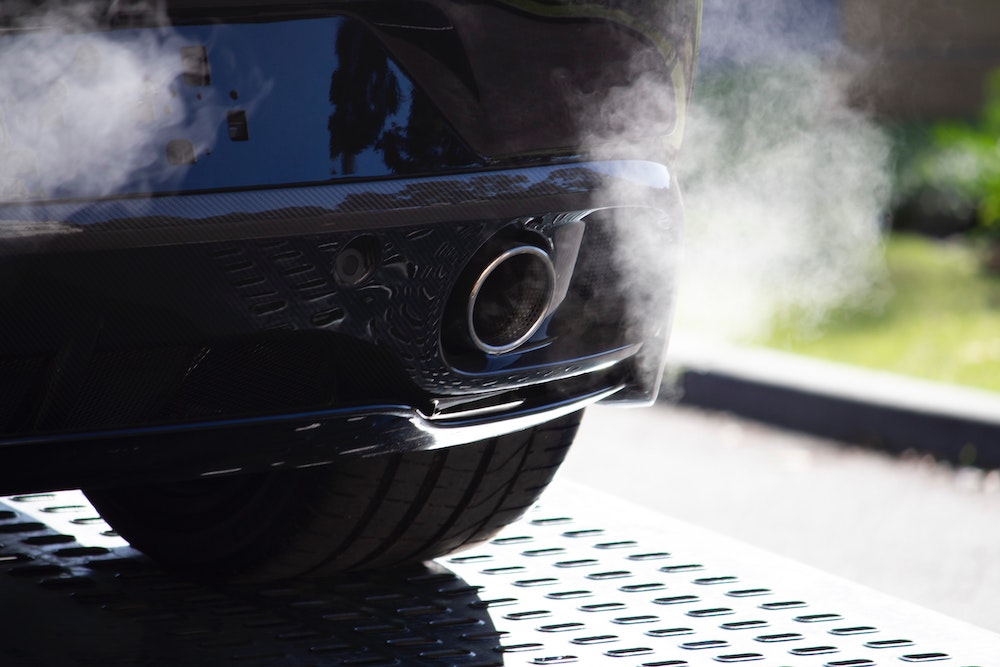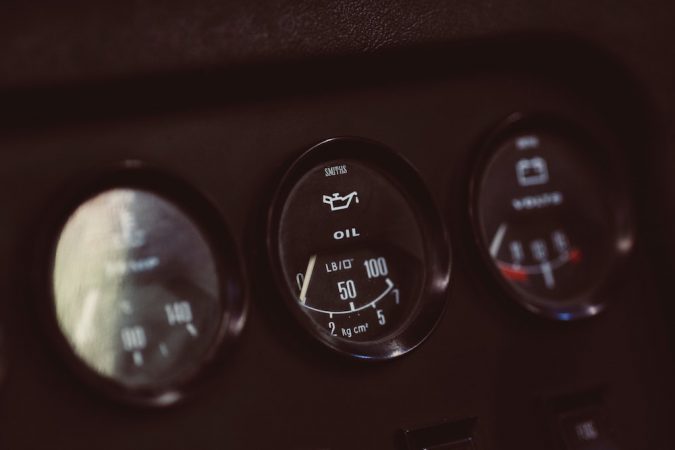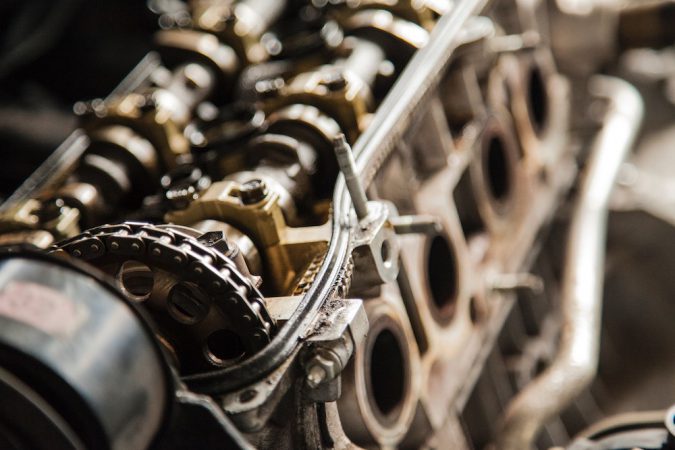Are you noticing lately how some black drops of oil coming out of exhaust? If this is the case, it should be alarming for you and you should immediately check the level of oil in your car. Because oil coming out of exhaust is not normal and this problem should be addressed as soon as possible. Now, we are going to tell you everything about this problem.
- What Is Engine Oil?
- Why Is Oil Coming Out?
- Probable Causes
- How To Diagnose?
- Cost To Repair
- Conclusion
The engine oil is one of the core fluids that are in your engine and makes it work. Without oil, the engine can’t run. The components would simply melt because the oil is not there to dissipate the heat and lubricate the components. That’s why observing your oil level is essential in your internal combustion vehicle if you don’t want permanent damage to be done to it.
But even though the oil is securely stored in your engine. It could still find its way out of it. Yes, that’s true. The oil can escape and results in numerous problems that can cause a lot of headaches for car owners. For example, this problem of oil coming out of exhaust. This problem is really serious and needs proper diagnosing and solving. And we are going to explain how you can do this diagnosing.
In this article, we are going to learn everything you need to know when it comes to oil coming out of the exhaust. We will start from the basics and learn more about engines and oil. Then we will cover the probable causes for this problem and then we will tell you how to solve the problem. So, let’s discuss.
What Is Engine Oil And How Does The Engine Work?
The engine oil is the fluid that makes your engine work properly. If there was no engine oil, then the engine will simply be exposed to extreme amounts of friction. This friction will cause the engine to warm up to melting temperatures. Then many of the internal components will end up damaged beyond repair.
The engine oils were usually made out of crude oil. But modern oils are made out of synthetic materials that have that much better lubricating ability as well a lot more durability. Mineral oils in the past weren’t as long-lasting compared to modern fully synthetic oils. If the average life for mineral oil is between 5 to 7 thousand miles, for fully synthetic oils, this usable lifespan is beyond that.
Some of these oils are claimed to last more than 15 thousand miles. But to be on the safe side, it is best to replace your engine oil every 5,000 to 7,500 miles. Doing regular oil changes will guarantee the longevity of your engine and as well keeping your budget low. Because if you have engine damage, you are going to pay a lot of money to get it fixed.
How the oil works is pretty simple. The oil in most internal combustion engines is at the bottom of the engine, in the oil pan. And as the engine cranks, the oil pump starts to spin and this oil pump disperses the oil around the engine. That’s how the lubrication system works inside of the engine.
But what about my problem with oil coming out of exhaust? Well, we are going to cover that problem in the next chapter along with the probable causes that make this problem appear in the first place.
Why There Is Oil Coming Out Of Exhaust?
Oil coming out of exhaust is not a normal occurrence and this should alert you to take any action to solve this problem.
But you should also know how to be sure that this is oil and not water. When there is oil or water spilled on the tarmac, there are the same dark spots.
A small amount of water is also pushed from the exhaust when the car runs. This water is caused by condensation. And this water can be mixed with the carbon deposits inside of your exhaust system and confuse you with oil.
That’s why when you are in this situation, the best thing you can do is to check the leaks carefully. Inspect them with your hand and if the substance is greasy then your car is spilling oil from the rear and this has to be checked. Or, if you inspect the fluid and the fluid is not greasy, then this is most likely condensation water. It’s a completely normal issue, especially when you run your car in the winter.
In the winter, the level of condensation is much higher than in the summer. So, you can expect some white smoke when you start your car and as well some water to be pushed out of the exhaust.
And if you notice oil coming out of exhaust, this should alert you for sure. The first thing you need to check is the oil level in your vehicle. The oil level is an indication that there is an oil-burning issue.
Remove the dipstick and check the level. If the level is low, then you know that you need to add more oil and troubleshoot the issue. But how you can do that? We are going to find out in the next chapter.
Probable Causes For Oil Coming Out Of Exhaust
As we said, if there is oil coming out of exhaust, you need to take action to diagnose the problem. But what you can do about it?
The first thing you need to do is to learn the probable causes for oil coming out of exhaust. That’s why we are going to list all the probable causes that make this problem possible. This is for you to have a better understanding of where to look and how to diagnose this issue.
Then, we are going to learn how you can diagnose the problem and the costs that will be involved in this work. That’s since all the different problems prices cost differently.
Blown Head Gasket -Oil Coming Out Of Exhaust
A blown head gasket is one of the first things that can come to mind when you have an oil-burning problem in your car. But what is a head gasket?
The head gasket is a special gasket material that is placed between the head of the engine and the block. This head gasket makes sure that there is a perfect seal and the fluids don’t enter in the combustion process as well as not mix between them.
When the head gasket breaks, depending on the place that it fails, will show different symptoms later on.
If the gasket is material is damaged on the outside of the block, then the coolant will leak from the outside. If the gasket is damaged on the inside, the coolant or oil will leak into the engine and cause an oil coming out of exhaust problem to appear.
Or if the gasket breaks somewhere in the middle. It may allow coolant and oil to mix between them. This mix is going to result in big sludge in your oil or cooling system.
But let’s stick to the problem of oil in the combustion chamber, since this is the main focus of this article. How you can diagnose if your gasket is allowing oil to pass into the combustion?
The only way to make sure that this is the case is to open the engine. The head has to be removed for the gasket to be inspected.
After inspection, the problem can be patched with a new head gasket and all the fluids flushed. This will guarantee you, as the owner, that no problem in the future will occur and no more oil coming out of exhaust.
Bad O-Rings
Bad O-Rings or oil rings as they are known can also cause oil coming out of exhaust problems to appear on your car and make your car spill oil as you drive on the road. But what are O-Rings?
The O-Rings are special material rings that are installed on the pistons of your engine. Their task is to make sure that no oil escapes from the oil galley into the combustion chamber. If the oil escapes through them, the engine in your car is going to start to develop issues and will start to burn oil.
The oil-burning problem is one of the most common issues found in internal combustion engines. This is the case because most of these oil rings are starting to lose their ability to hold the oil. Then, some fraction of this oil goes past the oil rings and ends up in the combustion process.
And if you have oil coming out of exhaust problem, then this means that some of the oil rings on your car are completely shut or broken. These broken oil rings don’t hold the oil and the oil goes past through them.
Since the oil is burning, your engine is constantly losing oil and is not lubricated. This oil loss will cause engine damage as well. So, when your engine is burning oil, make sure that you top off the oil regularly and avoid leaving your engine without oil.
These oil rings that are broken can also scar your cylinders and possibly damage other components in your engine. They will most likely end up in the oil pan.
How you can diagnose this issue we are going to discuss later in this article, but first, let’s look at the other causes why this happens.
Bad Valve Guides
The valve guides can also allow the oil to pass through, enter the engine, and cause oil coming out of exhaust problems to appear and ruin your day. But what are the valve guides?
The valve guides, as their name says, are guides that guide the valve. They are cylindrical-shaped components and are mounted on the top of the engine.
The valves basically get into the guides, and the guides are making sure that the valves are following this geometry. A good valve guide should not have any play. The distance between the valve stem and guide should only be a few fractions of an inch.
But when this distance is bigger. The valves are starting to have play and not seal properly. This bad clearance will allow the oil to pass through and enter inside of the cylinder.
Remember that the oil pump is pushing the oil even at the top of the engine when the head is located. This oil has to go somewhere and if there is too much play on the valve guides, it’s basically finding its way down in the cylinders.
And these oil leaks inside of the cylinder, firstly are going to increase your oil consumption and make your car puke oil from the exhaust if a couple of cylinders are affected by this problem.
Then, the second problem is the possible engine damage as there is a lack of lubrication in the engine by excessive oil burning. In this case, when you have oil coming out of exhaust problem is addressing the problem as soon as possible. But how can you do this work? We are going to answer that later in the article.
Bad Valve Seals
One of the most prevalent problems that cause oil leaks into the cylinder from the top side is the valve seals. But what are the valve seals?
The valve seals, as their name implies, are seals that are sealing the valves and prevent oil leaks into the cylinder. These seals are usually made out of plastic. And over time, they start to fail and the engine is starting to have increased oil consumption.
When the valve seals leak, you will notice how you have less and less oil in your oil pan. This is a clear indication that something is wrong with your engine and it needs checking.
The valve seals are not difficult to replace, but this work has to be done professionally and you will need professional equipment to perform this work.
Also, everything has to be realigned perfectly to avoid any future leaks and engine misfires if the valves are not adjusted properly.
When you are going to fix the valve seals, your problem with oil coming out of exhaust will be solved and your engine should be returned to proper working order. But how you can diagnose the problem and make sure which of these components that we listed is causing the issue? Let’s find out in the next chapter.
How To Diagnose And Repair The Problem?
Now, this is the important part. Diagnosing the problem and the possible outcomes. In this chapter, we are going to share some input on what you should be your next steps if you want to dive into the troubleshooting waters.
This can also be tricky to do since all the possibilities include massive engine work and tearing everything apart. This is the case because these problems are not visible and need some direct assessment to get them 100% diagnosed. Doing this will save you thousands of dollars if, for example, a mechanic misdiagnoses the problem on your car. That’s why if this car is old or a project, you can try doing the work by yourself.
Blown Head Gasket
The only way to diagnose a blown head gasket is to remove the engine head. For you to remove the head, you need to remove all the components that are on top of it. And these include the intake, coils, headcovers.
All these components need to come out for you to access the head bolts. Then, you will need a torque wrench to get the bolts loose. They are torqued to spec and without a torque wrench, it will be almost impossible to get them loose. Other components that you will have to remove before you get the bolts are the rocker arms and rods if your engine is a pushrod design engine.
Next thing is to remove the engine head. After removing the engine head, you can place it on a table.
Get the gasket out of the engine block and inspect places where could possibly the oil would leak. If you found your leak, great! But if you, didn’t you need to dive deeper and check the oil rings.
Broken Oil Rings
If your oil rings break, they can also cause a massive amount of oil to pass through and burn inside of the cylinder. But how you can check if they are good?
By doing the same process as we explained in the previous chapter. But in this case, you will also need to inspect the condition of the cylinders and see if they have damage. If they are damaged, you will need more than new oil rings for sure. Most probably, the block will require to be honed down to remove the scratches or machine worked.
Also, the pistons have to be removed and inspected. If you notice bad oil rings or missing rings, then you found your culprit. If not, you will have to check the heads.
Damaged Valve Stems And Valve Seals
Although we cover the valves last, they are the first items that you can check when you are dismantling the engine. That’s since they are the first ones that come out of the engine.
You need to see the conditions of the valves on the combustion side. See if there is any oil on them and if they are damaged, if you are having oil coming out of exhaust. These valves would be pretty much obliterated with oil and carbon.
In this case, the valve guides, valves, valve seals; everything has to be refreshed. And also, the head needs to be machined as well. And this can cost a lot, but how much? We are about to find out in the next chapter.
Cost To Repair The Oil Coming Out Of Exhaust Problem
The cost to repair this problem with oil coming out of exhaust can vary depending on the problem. The cheapest of the bunch of possibilities that can cause this problem is the head gasket.
In this case, head resurfacing and a new gasket will do the job. And this work is going to set you back between $500 to $800 depending much on how extensive the resurfacing work will be. Also getting a new head is an option if the old is too damaged. A new head is around $1,000. This is the way to go if you want everything to be perfect.
If the problem is the oil rings, then you will have to pay a lot of money to get this work done. A small refresh of the engine will be required and this will involve replacing all the bearings and piston rings.
These parts are cheap, but the work is very extensive and can cost between $1,000 to $1,500. Or if your engine needs machining work as well, you can expect to pay more than $2,000 for all this work.
That’s why considering a used engine if you are in this situation, is a good idea. With a used engine, you can be sure that it will work properly if the engine is low mileage. But with rebuilds, you never know.
If the valves are bad and the oil leaks from there. The only solution will be installing new head components. This is done by a machining shop as well. They are going to recondition the head and make it work for a price of $800. That’s why getting a new head sometimes is an option since a new head is around $1,000 and it’s much better than a used head.
Oil in Exhaust Pipe – Facts
- Fuel system issues are the 7th most common problem area, with around 70,000 reported cases to the U.S. Department of Transportation for cars made between 1996 and 2019.
- Oil leaking from the exhaust pipe is a common issue for used cars, and there are ways to troubleshoot and fix it at home.
- Soot buildup on the exhaust pipe can create an oil-like liquid and cause oil to leak from the exhaust. Running a finger on the inside of the pipe can help identify if there’s soot buildup.
- A congested PVC valve can force oil to pass several seals and into the exhaust pipe, and the warning signs for this issue are bluish smoke and oil-smeared spark plugs. Replacing the valve can easily address the problem.
- A ruptured head gasket can let fluids mix into the exhaust stream, and the symptoms of a blown gasket include an overheated engine, reduced engine performance, and excessive fuel burning. Changing the defective gasket can resolve the issue.
- Worn valve guides can cause engine oil leaks and run into the exhaust gases, leading to bluish smoke coming out of the tailpipe.
- Smoke colors from the tailpipe can indicate the type of oil coming out of the exhaust problem. Black smoke is unburnt fuel, while gray or bluish smoke is engine oil leaking into the internal combustion chamber.
- White smoke requires a thorough examination of the engine and could be caused by faulty piston oil rings or issues in the combustion chamber.
- As a car’s mileage increases, more worn parts can be found, making frequent maintenance and checking essential to ensure safe and hassle-free driving.
- The issue of oil leaking from the exhaust is a factor to consider when deciding to buy a used car.
Conclusion – Oil Coming Out Of Exhaust
In this article, we have covered a lot when it comes to the oil coming out of exhaust problem. We learned how the oiling system works and then we have covered all the possibilities when it comes to this issue.
As we said, the main culprits could be the valve stems and seals, the bad head gasket, and the oil rings. All these components when they fail, it can cause oil to enter into the combustion and cause a problem.
Then we have covered the diagnosing process and as well the prices that you can expect to pay to get this work done at a shop.




